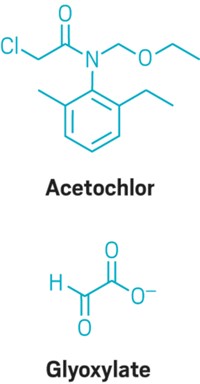Advertisement
Grab your lab coat. Let's get started
Welcome!
Welcome!
Create an account below to get 6 C&EN articles per month, receive newsletters and more - all free.
It seems this is your first time logging in online. Please enter the following information to continue.
As an ACS member you automatically get access to this site. All we need is few more details to create your reading experience.
Not you? Sign in with a different account.
Not you? Sign in with a different account.
ERROR 1
ERROR 1
ERROR 2
ERROR 2
ERROR 2
ERROR 2
ERROR 2
Password and Confirm password must match.
If you have an ACS member number, please enter it here so we can link this account to your membership. (optional)
ERROR 2
ACS values your privacy. By submitting your information, you are gaining access to C&EN and subscribing to our weekly newsletter. We use the information you provide to make your reading experience better, and we will never sell your data to third party members.
Environment
Glyphosate Metabolism
November 23, 2009
| A version of this story appeared in
Volume 87, Issue 47
The article "End of an Era" renewed my concerns about the molecular metabolic pathways of glyphosate (C&EN, July 20, page 30). I looked these up after seeing the similarity with methyl glycine or sarcosine in two separate articles in the Feb. 16 issue. Sarcosine was reported as a significant biomarker in human urine for prostate cancer and was shown in vitro to induce invasive growth in healthy prostate tissue (page 8). When I flipped the pages to the article on "Greening the Farm," I was stunned to see the glyphosate structure looking so similar to sarcosine (page 13). The article indicated that Greenpeace rather liked glyphosate because it has relatively low toxicity—how ironic if there are other problems.
A quick search shows that indeed common soil organisms metabolize glyphosate readily to sarcosine, although it is not the main metabolite. I have to wonder about the source of the elevated sarcosine in human urine. Is glyphosate residue in our diets and environmental exposure altering enzyme activities because its mode of action is enzyme inhibition for amino acid synthesis? Has our exposure increased since the introduction of glyphosate-tolerant genetically modified crops? Has anyone else speculated on this potential interaction now that the sarcosine biomarker is being studied?
We are playing with fire, hosing massive quantities of powerful chemicals into the environment and our food chain. Unintended consequences are commanding teachers.
John Rudesill
Columbia, Md.



Join the conversation
Contact the reporter
Submit a Letter to the Editor for publication
Engage with us on Twitter